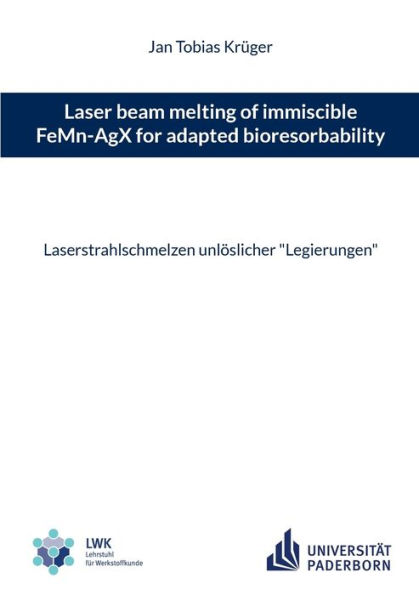Laser beam melting of immiscible FeMn-AgX for adapted bioresorbability: Laserstrahlschmelzen unl�slicher "Legierungen"
The application of Iron to open up new applications for bioresorbable implants is promising. However, modification of Iron is necessary to adjust the required properties. Alloying with Manganese improves the mechanical performance and increases the degradation rate. Further acceleration of degradation can be adjusting electrochemically noble phases to force the anodic dissolution of the Iron-based matrix. Since Silver and Iron are insoluble in each other, Silver phases can exist in an unmodified Iron-Manganese matrix. Silver is biocompatible and provides an antibacterial effect. If a degradable Silver alloy is used, the Silver phases can degrade after the Iron-Manganese matrix. One way to process metals that are not soluble in each other by melting metallurgy is powder-bed-based selective laser beam melting. The small melt pool, strong melt flow, and rapid solidification enable the inclusion of Silver in the Iron-Manganese matrix. To enable selective tailoring of the morphology, distribution, and chemical composition of the Silver phases, a model was developed for the interaction of the insoluble components in the melt pool and the formation of the Silver phases during laser beam melting. The principle effectiveness of anodic dissolution by Silver phases has been confirmed. However, this does not result in an increased degradation rate, since deposits with a blocking effect are formed.
1148457466
Laser beam melting of immiscible FeMn-AgX for adapted bioresorbability: Laserstrahlschmelzen unl�slicher "Legierungen"
The application of Iron to open up new applications for bioresorbable implants is promising. However, modification of Iron is necessary to adjust the required properties. Alloying with Manganese improves the mechanical performance and increases the degradation rate. Further acceleration of degradation can be adjusting electrochemically noble phases to force the anodic dissolution of the Iron-based matrix. Since Silver and Iron are insoluble in each other, Silver phases can exist in an unmodified Iron-Manganese matrix. Silver is biocompatible and provides an antibacterial effect. If a degradable Silver alloy is used, the Silver phases can degrade after the Iron-Manganese matrix. One way to process metals that are not soluble in each other by melting metallurgy is powder-bed-based selective laser beam melting. The small melt pool, strong melt flow, and rapid solidification enable the inclusion of Silver in the Iron-Manganese matrix. To enable selective tailoring of the morphology, distribution, and chemical composition of the Silver phases, a model was developed for the interaction of the insoluble components in the melt pool and the formation of the Silver phases during laser beam melting. The principle effectiveness of anodic dissolution by Silver phases has been confirmed. However, this does not result in an increased degradation rate, since deposits with a blocking effect are formed.
20.5
In Stock
5
1

Laser beam melting of immiscible FeMn-AgX for adapted bioresorbability: Laserstrahlschmelzen unl�slicher "Legierungen"
146
Laser beam melting of immiscible FeMn-AgX for adapted bioresorbability: Laserstrahlschmelzen unl�slicher "Legierungen"
146Paperback
$20.50
20.5
In Stock

Product Details
| ISBN-13: | 9783734707308 |
|---|---|
| Publisher: | Bod - Books on Demand |
| Publication date: | 04/24/2023 |
| Pages: | 146 |
| Product dimensions: | 5.83(w) x 8.27(h) x 0.31(d) |
From the B&N Reads Blog
